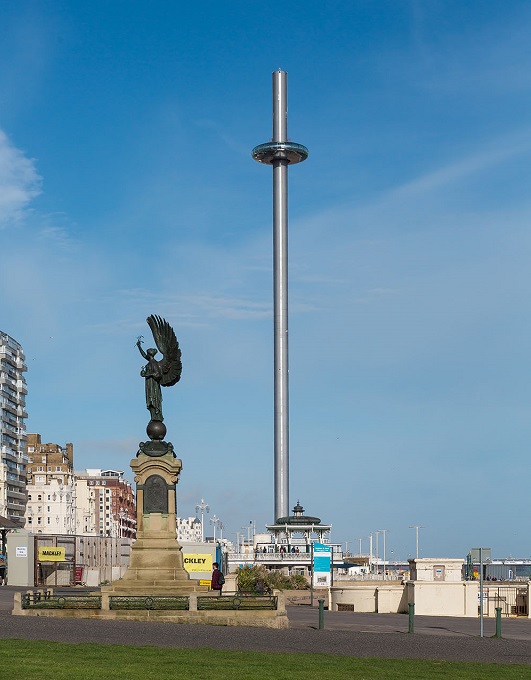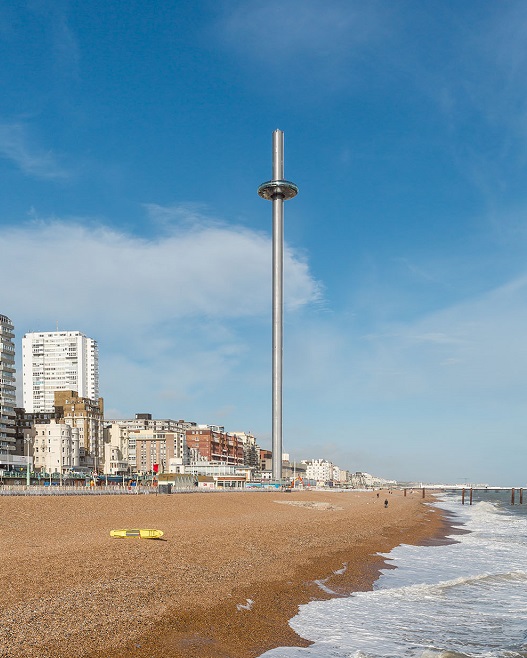British Airways i360 observation tower
On 4 August 2016, British Airways i360, the world’s tallest moving observation tower, opened to the public. Located on Brighton beach, developers hope the tower transforms the town's tourism prospects.
British Airways i360 was conceived and designed by Marks Barfield Architects, creators of the London Eye. The pod has been designed and built by cable car specialists POMA, who built the capsules for the London Eye. At 18 m (59ft) wide, the viewing pod is 10 times bigger than a capsule on the London Eye.
The overall height of the tower is 162 m, with an observation pod that rises from ground level to 138 m, offering 360-degree views of Brighton and Hove, the Sussex coast and the English Channel. It also holds the Guinness World Record for the most slender tower in the world, with its widest point being just 3.9 m.
Movement tests on the pod began earlier in June, progressing to a height of 30 m before reaching its full height on the 14th June.
The curved-glass pod is capable of carrying up to 200 visitors per ‘flight’, which lasts a total of 20 minutes (30 in the evening). The concept of the tower is that it will serve as a ‘vertical pier’, sited as it is at the root end of Brighton’s historic West Pier which closed in 1975 and remains in ruins following a fire in 2003.
The tower has its detractors though, with some describing it as an 'eyesore' which 'ruins the sea views' of Brighton.
The attraction’s visitor centre will incorporate a 400-seat restaurant The Belle Vue Brighton, a gift shop, a children’s play zone, an exhibition space, and conference and event facilities.
For more information, please see British Airways i360.
Content and images: British Airways i360 ‘The British Airways i360 pod reaches its maximum height of 138m for the first time.’
[edit] Related articles on Designing Buildings Wiki
Featured articles and news
RTPI leader to become new CIOB Chief Executive Officer
Dr Victoria Hills MRTPI, FICE to take over after Caroline Gumble’s departure.
Social and affordable housing, a long term plan for delivery
The “Delivering a Decade of Renewal for Social and Affordable Housing” strategy sets out future path.
A change to adoptive architecture
Effects of global weather warming on architectural detailing, material choice and human interaction.
The proposed publicly owned and backed subsidiary of Homes England, to facilitate new homes.
How big is the problem and what can we do to mitigate the effects?
Overheating guidance and tools for building designers
A number of cool guides to help with the heat.
The UK's Modern Industrial Strategy: A 10 year plan
Previous consultation criticism, current key elements and general support with some persisting reservations.
Building Safety Regulator reforms
New roles, new staff and a new fast track service pave the way for a single construction regulator.
Architectural Technologist CPDs and Communications
CIAT CPD… and how you can do it!
Cooling centres and cool spaces
Managing extreme heat in cities by directing the public to places for heat stress relief and water sources.
Winter gardens: A brief history and warm variations
Extending the season with glass in different forms and terms.
Restoring Great Yarmouth's Winter Gardens
Transforming one of the least sustainable constructions imaginable.
Construction Skills Mission Board launch sector drive
Newly formed government and industry collaboration set strategy for recruiting an additional 100,000 construction workers a year.
New Architects Code comes into effect in September 2025
ARB Architects Code of Conduct and Practice available with ongoing consultation regarding guidance.
Welsh Skills Body (Medr) launches ambitious plan
The new skills body brings together funding and regulation of tertiary education and research for the devolved nation.
Paul Gandy FCIOB announced as next CIOB President
Former Tilbury Douglas CEO takes helm.
UK Infrastructure: A 10 Year Strategy. In brief with reactions
With the National Infrastructure and Service Transformation Authority (NISTA).


























Comments
What an eye sore!